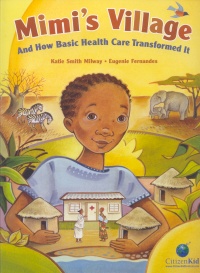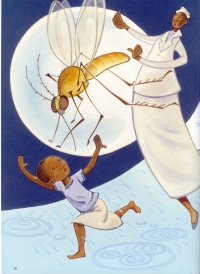| ________________
CM . . . . Volume XIX Number 9 . . . . November 2, 2012
excerpt:
Though many North Americans take clean water and access to medical care for granted, in many parts of the world the water is unfit to drink, and illness and disease are widespread, often leading to premature death due to inadequate or unavailable health care. Mimi's Kenyan village is one such example. A work of fiction, this book is based on a composite of real people and events and is the latest title in the "CitizenKid" collection of books which are designed to teach readers about various parts of the world and inspire them to become better global citizens.
At the back of the book are half a dozen pages with factual information. Firstly, author Milway provides the basis for the story. One woman, Felina Maiya, was instrumental in making the citizens of a Zambian village healthier and safer, for, not only did she act as a health worker, but also as a teacher and promoter of good hygiene. Secondly, Milway explains why basic health care is so important. Finally, she gives readers some examples of projects and organizations which are helping people in many parts of the world. Some of these are World Vision, Nets for Life Africa, Save the Children and Hoops of Hope. Readers are encouraged to donate a portion of their allowance or to think of ideas of their own that will make the world a better place for those who lack basic health care. The text of the story is written in short, single-page chapters which are easy for readers to comprehend; however, the text in the factual portion of the book is slightly more difficult for young readers and might require an adult's assistance. A minor flaw is the book's title which is rather dull and reveals the story's entire premise. Illustrations consist of acrylic paintings, rendered in soft edges and muted tones, especially of gold, blue and green. The paintings accurately depict the story's Kenyan setting, its flora and fauna as well as the homes and clothing of the people, therby lending authenticity. In the factual portion of the book are vivid colour photographs as well as a map and a glossary. Although not the best of the titles in the "CitizenKid" collection, this book, nevertheless, will not only help readers to gain an appreciation for the kind of health care they have in North America, but its contents might also inspire them to social action. Recommended. Gail Hamilton is a former teacher-librarian in Winnipeg, MB.
To comment
on this title or this review, send mail to cm@umanitoba.ca.
Copyright © the Manitoba Library Association. Reproduction for personal
use is permitted only if this copyright notice is maintained. Any
other reproduction is prohibited without permission.
NEXT REVIEW |
TABLE OF CONTENTS FOR THIS ISSUE
- November 2, 2012.
AUTHORS |
TITLES |
MEDIA REVIEWS |
PROFILES |
BACK ISSUES |
SEARCH |
CMARCHIVE |
HOME |

 When Mimi's younger sister becomes seriously ill, Mimi's family walks to a neighbouring village to get help at the clinic. Inspired by the work of Nurse Tela, who not only cares for the sick but also weighs babies to monitor their growth, dispenses pills and gives vaccinations, Mimi asks her father if he could build a clinic in their home village. After discussing the idea with the village elders, the men agree, and with the donation of materials and a plot of land from the mission church and free labour from the men, a small clinic soon becomes a reality. Using a portion of the profits from their maize crops, the villagers are able to afford a nurse and some medical supplies. Thanks to Nurse Tela's regular visits to the new clinic, the villagers learn healthy habits, such as how to wash produce in water mixed with a bit of bleach in order to kill the germs, how to create a more nutritious maize porridge by adding fresh vegetables, and the importance of sleeping under insecticide-sprayed mosquito nets to prevent malaria. Nurse Tela also trains Mimi's mother to deliver babies and other moms how to weigh them and dole out medication when Nurse Tela is unavailable.
When Mimi's younger sister becomes seriously ill, Mimi's family walks to a neighbouring village to get help at the clinic. Inspired by the work of Nurse Tela, who not only cares for the sick but also weighs babies to monitor their growth, dispenses pills and gives vaccinations, Mimi asks her father if he could build a clinic in their home village. After discussing the idea with the village elders, the men agree, and with the donation of materials and a plot of land from the mission church and free labour from the men, a small clinic soon becomes a reality. Using a portion of the profits from their maize crops, the villagers are able to afford a nurse and some medical supplies. Thanks to Nurse Tela's regular visits to the new clinic, the villagers learn healthy habits, such as how to wash produce in water mixed with a bit of bleach in order to kill the germs, how to create a more nutritious maize porridge by adding fresh vegetables, and the importance of sleeping under insecticide-sprayed mosquito nets to prevent malaria. Nurse Tela also trains Mimi's mother to deliver babies and other moms how to weigh them and dole out medication when Nurse Tela is unavailable.